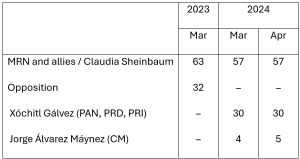In most democracies, opinion polls routinely ask voters how they intend to vote in an upcoming election. The press and other media use these poll results, specifically the aggregated percentage measures of voting intentions for candidate X, to indicate the likelihood of that candidate winning. While this approach is a practical means of predicting election outcomes, there is a lesser-known survey item that can also serve this purpose, namely questions about voter expectations rather than voter intentions. For example, “Who do you think will win?” rather than “Who are you going to vote for?”
A growing body of research has examined the accuracy of voter expectations relative to voter intentions. The most comprehensive work on the subject, looking at more than 400 election surveys in the UK in the post-World War II period, demonstrates that voter expectations are significantly more accurate than voter intentions in predicting election outcomes. These forecasts based on voter expectations have been termed ‘citizen forecasts,’ in a seminal paper on the American case.
In other established democracies, citizens are also remarkably good at forecasting the winner of elections. However, we know little about citizen forecasting in emerging democracies. In particular, it is unclear whether citizens can forecast well at the beginning of democracy or if election forecasting is a skill they develop over time. For instance, in the new democracies of post-communist Eastern Europe, knowledge of some electoral rules, such as government accountability for bad policies, was not immediately acquired. Can democratic citizens, exercising their election forecasting skills de novo, get it right? Or does it take time? If Mexican voters can do so now, what do they predict for the upcoming Mexican presidential election on 2 June 2024?
Historical context of democratic politics and elections in Mexico
In the 1990s, the once hegemonic Institutional Revolutionary Party (PRI) began to lose its grip on power. Mexico transitioned from a one-party, hegemonic system to a multi-party, competitive system. Although presidential elections have been free and fair since at least 2000, unwarranted suspicions of electoral fraud persist among some sections of the public. These suspicions were re-ignited after the 2006 elections, when the National Action Party (PAN) narrowly won re-election against the Party of the Democratic Revolution (PRD).
Past forecasting accuracy in Mexico
Against this background of a recent transition to free and fair elections and persistent doubts about electoral fraud, it is perhaps not surprising that most citizens incorrectly predicted the outcome of the 2000 presidential election. As Table 1 below shows, most citizens thought that the PRI would win in 2000, when in fact it was the PAN that won. In 2006, too, most citizens were wrong most of the time in the run-up to the election, although they got it right just before the election. Since then, Mexicans have correctly forecasted every presidential election. In 2012, they correctly predicted that the PRI would win the presidency. Given the bias in favour of the PRI in previous election forecasts, this may not be strong evidence in favour of citizen forecasting. However, citizens correctly predicted that López Obrador of the National Regeneration Movement (MRN) would be elected president in 2018.
Table 1. Percent of citizens who think that a party will win the Mexican presidential election, 2000–2018.
Sources: Murr based on Mexico Panel Study (2000–2012) and Investigaciones Sociales Aplicadas (2006–2018).
These results suggest that citizens need some time to develop an accurate forecasting skill and to trust the integrity of the elections enough to not suspect foul play. However, this learning curve appears to be relatively short; after one or two elections, citizens’ forecasting accuracy improves significantly. Unfortunately, long time series data on this question are scarce in established democratic polities, making it difficult to fully test this hypothesis. However, in addition to the UK work cited above, we have a good series for the US from the American National Election Study (ANES). As early as 1956, near the dawn of widespread, scientific, national election polling, the citizen forecasting question was posed prior to the presidential election. In the earliest of these surveys, from 1956 to 1968, 71 percent of voters were able to forecast the winner. This ‘acquired’ level of efficacy already matched the average for the entire series under investigation, i.e., 71 percent across the period (1956-1996). Moreover, in the very first of these surveys, the estimate reached 78 percent. The suggestion, still worth further investigation, is that citizen forecasting has a steep ‘learning curve’ , rendering the Mexican experience quite plausible.
The Mexican 2024 presidential election
So what about the 2024 presidential election? Will Claudia Sheinbaum, the candidate of the incumbent Morena party, win? Or will Xóchitl Gálvez, the candidate of the main opposition alliance between PAN, PRI, and PRD, or even Jorge Álvarez Máynez, the candidate of the small opposition party Citizens’ Movement (CM), win? As Table 2 below shows, most citizens forecast that Sheinbaum will win. Indeed, they already forecasted Morena to win over a year ago. Of course, we will soon know whether they are right, and how other forecasting approaches fared.
Table 2. Percent of citizens who think that a party (Mar 2023) or candidate (Mar & Apr 2024) will win the 2024 Mexican presidential election.

Source: Investigaciones Sociales Aplicadas
Note: This article reflects the views of the author and not the position of the DPIR or the University of Oxford.



